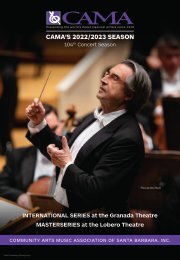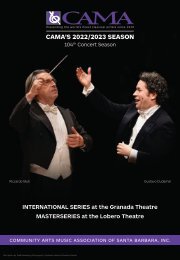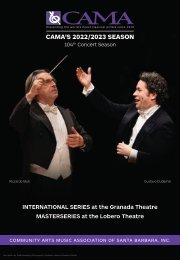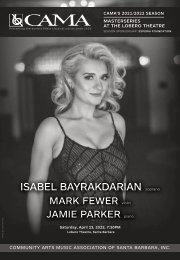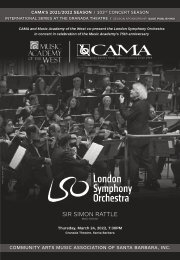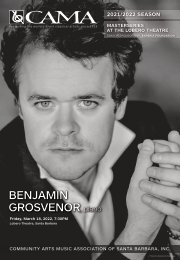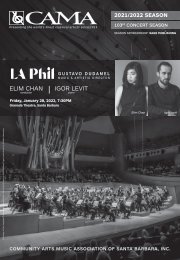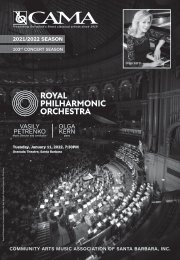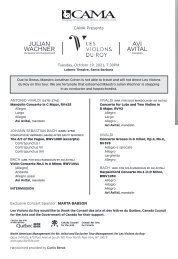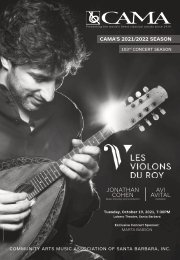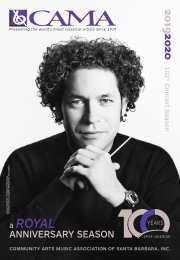Program Book / October 10, 2022 / CAMA Presents the City of Birmingham Symphony Orchestra with Mirga Gražinytė‑Tyla and Sheku Kanneh‑Mason
The Board of Directors of Community Arts Music Association dedicate this concert to the memory of Her Majesty The Queen Elizabeth II and of Her Majesty's 70 years of service to the people of the United Kingdom, the Realms, and the Commonwealth. MONDAY, OCTOBER 10, 2022, 7:30PM City of Birmingham Symphony Orchestra Mirga Gražinytė‑Tyla, Music Director Sheku Kanneh‑Mason, cello The City of Birmingham Symphony Orchestra is the flagship of musical life in Birmingham—and one of the world’s great orchestras. The tradition began with their very first concert back in 1920—conducted by Sir Edward Elgar. The CBSO became internationally famous when conductor Simon Rattle took the helm in 1980. In 2016, the CBSO welcomed the appointment of Mirga Gražinytė-Tyla, a native of Vilnius, Lithuania, as its Music Director, following her time with the Los Angeles Philharmonic as a Dudamel Fellow, Assistant Conductor, and Associate Conductor. British cellist Sheku Kanneh-Mason became a household name in 2018 after performing at the wedding of Prince Harry and Meghan Markle at Windsor Castle, watched by nearly two billion people globally. Sheku’s album Elgar on the Decca Classical label made him the first cellist in history to reach the UK Top 10. PROGRAM: RALPH VAUGHAN WILLIAMS: Fantasia on a Theme by Thomas Tallis SIR EDWARD ELGAR: Cello Concerto in E Minor, Op.85 MIECZYSŁAW WEINBERG: “Jewish Rhapsody,” from Festive Scenes, Op.36 CLAUDE DEBUSSY: La Mer PRE-CONCERT LECTURE: Jennifer Kloetzel, Professor, Cello and Head of Strings, UCSB Department of Music Sullivan Goss Art Gallery, 11 E. Anapamu Street, Santa Barbara Doors open 5:45PM ⫽ Lecture 6:00–6:40PM Presented by the CAMA Women’s Board •
The Board of Directors of Community Arts Music Association dedicate this concert to the memory of
Her Majesty The Queen Elizabeth II and of Her Majesty's 70 years of service to the people of the
United Kingdom, the Realms, and the Commonwealth.
MONDAY, OCTOBER 10, 2022, 7:30PM
City of Birmingham Symphony Orchestra
Mirga Gražinytė‑Tyla, Music Director
Sheku Kanneh‑Mason, cello
The City of Birmingham Symphony Orchestra is the flagship of musical life in Birmingham—and one of the world’s great orchestras. The tradition began with their very first concert back in 1920—conducted by Sir Edward Elgar. The CBSO became internationally famous when conductor Simon Rattle took the helm in 1980. In 2016, the CBSO welcomed the appointment of Mirga Gražinytė-Tyla, a native of Vilnius, Lithuania, as its Music Director, following her time with the Los Angeles Philharmonic as a Dudamel Fellow, Assistant Conductor, and Associate Conductor. British cellist Sheku Kanneh-Mason became a household name in 2018 after performing at the wedding of Prince Harry and Meghan Markle at Windsor Castle, watched by nearly two billion people globally. Sheku’s album Elgar on the Decca Classical label made him the first cellist in history to reach the UK Top 10.
PROGRAM:
RALPH VAUGHAN WILLIAMS: Fantasia on a Theme by Thomas Tallis
SIR EDWARD ELGAR: Cello Concerto in E Minor, Op.85
MIECZYSŁAW WEINBERG: “Jewish Rhapsody,” from Festive Scenes, Op.36
CLAUDE DEBUSSY: La Mer
PRE-CONCERT LECTURE:
Jennifer Kloetzel, Professor, Cello and Head of Strings, UCSB Department of Music
Sullivan Goss Art Gallery, 11 E. Anapamu Street, Santa Barbara
Doors open 5:45PM ⫽ Lecture 6:00–6:40PM
Presented by the CAMA Women’s Board
•
You also want an ePaper? Increase the reach of your titles
YUMPU automatically turns print PDFs into web optimized ePapers that Google loves.
The text’s aggressive cast led Tallis
to write a tune in Phrygian mode, which is
mostly a minor scale (E to E on the white
keys), but with mostly major harmonies,
and it may have been this tonal ambiguity
that attracted Vaughan Williams. He used
it as the tune for more modern texts, and
later in music for Bunyan’s Christian allegory
A Pilgrim’s Progress. It was still on his
mind when he was invited to contribute a
new work for the 1910 Three Choirs Festival
in Gloucester. It was with the recesses
of that ancient Gothic church in mind that
Vaughan Williams composed the Fantasia
on a Theme of Thomas Tallis.
The Fantasia is scored in 14 parts—
two five-part string orchestras, one with
more players on a part than the other, and
a quartet of soloists—that echo each other,
answer each other, and often combine into
one five-part tutti.
Vaughan Williams presents the theme
with Tallis’ basic harmonization, but it
seems right at home in its setting, rather
than a visitor from four or five centuries
ago. It is treated freely, with shifting meter
and tonality. The composer may have
thought it all a little too free, as he revised
it twice, once for the 1913 London premiere
and once in 1919, shortening it each time.
The Fantasia is about how beautiful
music can be and how good a string ensemble
can sound, and manages to do it
without becoming syrupy, which is a magnificent
achievement. It is both a complex
work with depth and the ultimate feel-good
piece, which has made ubiquitous in the
repertoire: it was commercially recorded 61
times between 1936 and 2022.
Sir Edward Elgar’s Cello Concerto came at
the end of two eras. The most obvious end
was the old order in Europe, destroyed by
World War I along with a staggering number
of its young men. It was also the end of the
two-decade era in which Elgar had stood
atop the British musical world. The era began
when the Enigma Variations catapulted
the 42-year-old composer from obscurity to
stardom in 1899, and continued with years
of remarkable creative fertility in which he
composed virtually all the music for which
he is known now.
The war slowed Elgar’s output to a
trickle, and toward its end his finances and
health were suffering. “I am more alone
and the prey of circumstances than ever
before,” he said. “Everything good and nice
and clean and fresh and sweet is far away,
never to return.”
In March 1918, he had his tonsils removed
at his doctor’s urging, and was in
pain for days, pain relief in 1918 being nothing
close to what it is now. “But nevertheless,”
his daughter Carice wrote, “he woke
up one morning and asked for pencil and
paper and wrote down the opening theme
of the Cello Concerto.” He did not yet know
it would wind up in a cello concerto, and
nothing came of it for while longer, as Elgar
plunged into composing three significant
chamber works. By the time they were finished
in May 1919, the cello concerto was
16 CAMA'S 104 TH CONCERT SEASON




